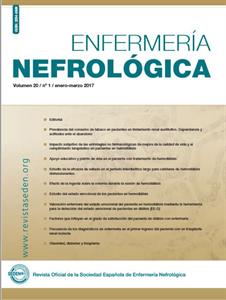Contenido del artículo principal
Resumen
Introducción: Actualmente el número creciente de personas en tratamiento de hemodiálisis aunado al incremento de incidencia de complicaciones agudas, pone de manifiesto implementar estrategias que favorezcan conductas o hábitos saludables disminuyendo las consecuencias personales, familiares y gastos institucionales.
Objetivos: Determinar la influencia del apoyo educativo de enfermería en el patrón de vida del paciente con insuficiencia renal crónica en tratamiento de hemodiálisis.
Metodología: Estudio pre-experimental donde participaron 22 pacientes en hemodiálisis, se diseñó y ejecutó un programa educativo bajo el referente teórico de Orem con enfoque en tres dimensiones: Responsabilidad en Salud, Alimentación e Higiene, consistió en diez sesiones de media hora dos veces por semana durante la primera hora de tratamiento del paciente.
Resultados: Edad promedio de 36.4 ± 16.7 años, con igual distribución tanto para hombres como mujeres (n=11); el 68.1% (n=15) de los pacientes son económicamente activos, reportando un tiempo promedio de 20.6 ± 15.6 meses de tratamiento en hemodiálisis. Se obtuvo un valor de mediana en la fase de pre-intervención de 92 y, de 107.5 en la fase post-intervención. Con una diferencia estadísticamente significativa entre ambas de p<0.001.
Conclusión: El 100% de los sujetos mantiene un patrón de vida protector, lo que sugiere que el Apoyo Educativo de Enfermería aumenta el patrón de vida del paciente con tratamiento de hemodiálisis. Lo que hace trascendente el papel de enfermería en la promoción de conductas generadoras de salud.
Objetivos: Determinar la influencia del apoyo educativo de enfermería en el patrón de vida del paciente con insuficiencia renal crónica en tratamiento de hemodiálisis.
Metodología: Estudio pre-experimental donde participaron 22 pacientes en hemodiálisis, se diseñó y ejecutó un programa educativo bajo el referente teórico de Orem con enfoque en tres dimensiones: Responsabilidad en Salud, Alimentación e Higiene, consistió en diez sesiones de media hora dos veces por semana durante la primera hora de tratamiento del paciente.
Resultados: Edad promedio de 36.4 ± 16.7 años, con igual distribución tanto para hombres como mujeres (n=11); el 68.1% (n=15) de los pacientes son económicamente activos, reportando un tiempo promedio de 20.6 ± 15.6 meses de tratamiento en hemodiálisis. Se obtuvo un valor de mediana en la fase de pre-intervención de 92 y, de 107.5 en la fase post-intervención. Con una diferencia estadísticamente significativa entre ambas de p<0.001.
Conclusión: El 100% de los sujetos mantiene un patrón de vida protector, lo que sugiere que el Apoyo Educativo de Enfermería aumenta el patrón de vida del paciente con tratamiento de hemodiálisis. Lo que hace trascendente el papel de enfermería en la promoción de conductas generadoras de salud.
Palabras clave
ENFERMERÍA
APOYO EDUCATIVO
HEMODIÁLISIS
Detalles del artículo
Licencia
Aviso de derechos de autor/a
© Los autores ceden de forma no exclusiva los derechos de explotación de los trabajos publicados y consiente en que su uso y distribución se realice con la Licencia Creative Commons Atribución - No comercial 4.0 Internacional (CC BY-NC 4.0). Puede consultar desde aquí la versión informativa y el texto legal de la licencia. Esta circunstancia ha de hacerse constar expresamente de esta forma cuando sea necesario.
Cómo citar
1.
Vázquez Espinoza JA, Velasco Rodríguez R, Alcaraz Moreno N, Pérez Hernández MG, Casique Casique L. Apoyo educativo y patrón de vida en el paciente con tratamiento de hemodiálisis. Enferm Nefrol [Internet]. 2017 [consultado 19 Dic 2025];20(1):[aprox. 9 p.]. Disponible en: https://www.enfermerianefrologica.com/revista/article/view/4045




